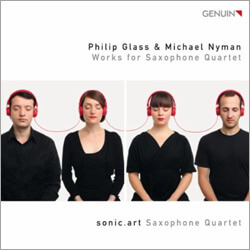 There are two multi-movement works by Philip Glass and one by Michael Nyman on the new album released by the Sonic Art Saxophone Quartet. Taken as complete wholes, none of the three is outstanding, though there are individual movements within them that are very powerful.
There are two multi-movement works by Philip Glass and one by Michael Nyman on the new album released by the Sonic Art Saxophone Quartet. Taken as complete wholes, none of the three is outstanding, though there are individual movements within them that are very powerful.
The “Mishima” quartet is actually an adaptation for saxophones of a work Glass originally wrote for strings, part of the soundtrack for the movie Mishima: A Life in Four Chapters. Many critics, myself included, often excoriate Glass for the lack of harmonic development in his pieces. Here, however, his stylistic signature does not severely detract from the pieces’ sense of forward motion; each idea is repeated, true, but not so many times as to become tiresome. They all share a tone of brooding mixed with quiet menace that is quite striking. It helps that they are short pieces; none of the six movements is longer than three and a half minutes, and the second and fourth are barely more than a minute each.

I’ve been listening to the string version of “Mishima” for comparison, and I think it actually comes off slightly better on the saxophones. The constant eighth-note pulses that are so characteristic of Glass seem somehow more live played on winds, as do the ascending arpeggios. The performers do an excellent job of giving different emphases to each note in a phrase, making the smallest variation truly stand out. The string version, by contrast, has a certain homogeneity that renders the pieces more emotionally distant.
The next work, also by Glass, is simply entitled “Saxophone Quartet,” and it is a somewhat strangely organized four-movement piece. The first movement is sad and minor. The main melody carried on the soprano sax is lyrical enough, but the accompaniment is generally uninspired. As a longer work, around five and a half minutes, it does suffer from a bit of that Glassian repetitiveness, as certain segments are heard several times without adding anything to the musical or emotional impact on the listener. The second movement is considerably more energetic and daring (part of the reason why the overall organization of the movements is confusing); it evokes imagery of scaling a great but precarious height, the excitement and tension building and building until a final explosion of melodic energy sends it all tumbling down. The ensemble works together more effectively here; rather than one instrument having the melody while the others play repeating patterns, there is a great deal of trading back and forth, and phrases of powerful homophony as well, particularly towards the end. Unfortunately, the third movement is both the longest and the dullest. It has neither the excitement of the second nor the lyricism of the first. Glass also returns to a much more straightforward arranging technique for much of the movement, with each of the players getting their turn having the primary melody, while the others play the same old interlocking pulse pattern. There is a new melodic idea introduced briefly about three-quarters of the way through, but then it disappointingly leads to nothing more than one more time through the main theme.
 Luckily, the fourth movement makes up for the flaws in the rest of the longer work, and then some. It is amazing, probably my single favorite piece by Glass. The stuttering, syncopated rhythmic motive is inseparable from the driving melodic line, that here undergoes actual transformation and development as the piece goes on. The melodic statements are interspersed with swirling loops and turns in a new register and instrument, and these transitions are organic, vital, and varied. Because this movement has some actual structure and meaningful form to it, the restatement of the main theme, when it occurs, feels like an actual arrival, not simply another repetition. The climax features some striking dynamic changes, with sudden quiet moments that are in turn overwhelmed by storms of very fast runs on the bari sax, all leading to a strong and explosive conclusion that hits like a ton of bricks. Why can’t Glass write more pieces that are this well put together?
Luckily, the fourth movement makes up for the flaws in the rest of the longer work, and then some. It is amazing, probably my single favorite piece by Glass. The stuttering, syncopated rhythmic motive is inseparable from the driving melodic line, that here undergoes actual transformation and development as the piece goes on. The melodic statements are interspersed with swirling loops and turns in a new register and instrument, and these transitions are organic, vital, and varied. Because this movement has some actual structure and meaningful form to it, the restatement of the main theme, when it occurs, feels like an actual arrival, not simply another repetition. The climax features some striking dynamic changes, with sudden quiet moments that are in turn overwhelmed by storms of very fast runs on the bari sax, all leading to a strong and explosive conclusion that hits like a ton of bricks. Why can’t Glass write more pieces that are this well put together?
Michael Nyman’s collection “Songs for Tony,” also a four-movement work, begins very promisingly. In the first movement, Nyman sets up a powerful, swift-moving minor mode riff that juxtaposes the high and low registers of the ensemble. The energy of the original hook never relents, but the melody that emerges and is carried primarily by the tenor sax is surprisingly sensitive and touching. The warm, Renaissance-like concluding cadence is a nice touch as well.
The other three movements, regrettably, never attain the same vitality as the first. They tread by-now familiar sax quartet territory, with melodies and harmonies that are at best clichéd and at worst simply plodding. The third movement’s main theme is memorable, even catchy, but the transformations it undergoes are unconvincing and ultimately not very, well, transformative. While in the fourth movement, Nyman aims for real subtlety with an extremely quiet main melody in the bari sax, that is only lightly accompanied. The patience required to wait while the piece slowly builds is not rewarded by anything particularly revelatory, however, only more of the same, with an inconclusive, anemic ending that feels more like someone simply shut off the mikes in the studio, rather than a real conclusion.

Speaking of microphones and studios… as someone whose main training is in composition, most of my thinking when I hear a new album goes towards the architecture of the pieces and the like, but of course there are purely production-oriented considerations to take into account as well. The truth is, while the album’s performances didn’t detract from my enjoyment of the pieces, neither did they enhance it. Although both the playing and the engineering are smooth and competent, with even very subtle key-clicks and the like rendered expertly and audibly, there is a slight lack of crispness to some of the articulations that make already slow pieces bog down a bit. The exception, as noted above, is the rendering of the beautiful main melody of the first movement of “Songs For Tony.” Which brings me back around full circle, and leads me to conclude that the performances were really dictated by the strengths and weaknesses of the compositions—but that could just be my personal bias.
The Sonic Art Quartet’s album is, overall, pleasant but uneven. The second and third works presented have beautiful moments, but in most of the cases there is too much dead air between them to allow the music as a whole to come alive. For fans of the original version of the “Mishima” quartet, the reworking for saxophones is worth hearing, and the strongest movements of each of the two other offerings deserve to be entered into the canon of literature for the sax quartet. But there is a great deal of skippable material here as well, and all but the most completionist of listeners will want to acquire individual tracks rather than the whole thing.
Sonic Art, Glass & Nyman: Works for Saxophone Quartet (2011, Guenin) – Buy on Amazon
—
Matt Weber is a New York based composer, educator, and political slacktivist.
























